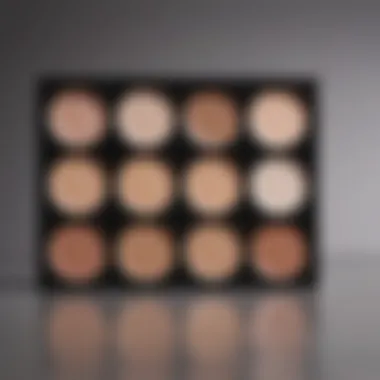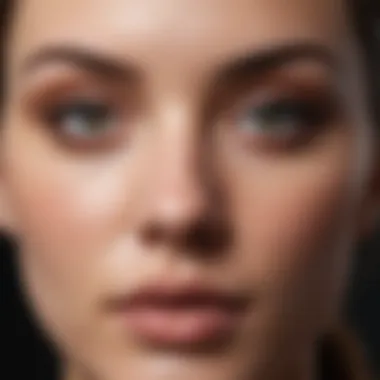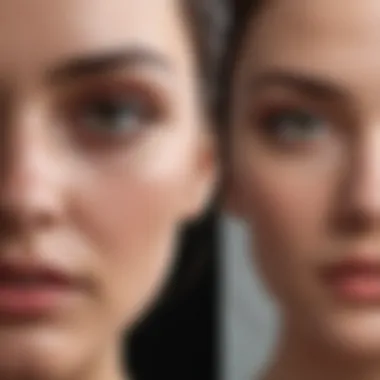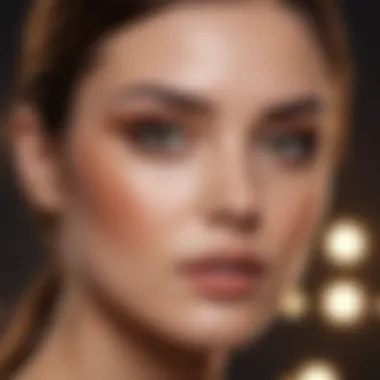Effective Makeup Solutions for Dark Circles


Intro
Dark circles are a common concern for many, transcending age and skin type. They manifest due to various reasons, including genetics, lack of sleep, stress, and even dietary habits. Concealing these imperfections not only restores confidence but also enhances overall appearance. However, the challenge lies in selecting the right makeup products and techniques that cater to individual skin tones and concerns.
In this article, we will explore the effective solutions in the realm of makeup for dark circles. We will discuss foundational concepts such as color theory, which plays a significant role in choosing the right concealer. Furthermore, we will detail essential application methods and layering techniques to achieve a seamless look. Understanding the crucial factors when considering products is vital for ensuring long-lasting wear.
Additionally, we will reveal specific high-quality products that are proven to work across diverse skin tones. Common mistakes will also be highlighted to prevent potential pitfalls when trying to perfect the art of covering dark circles. Our aim is to provide comprehensive guidance to help readers navigate this often-overlooked area of beauty, supporting them in making informed choices.
Understanding Dark Circles
Dark circles under the eyes are a common concern for many people. They can make individuals look tired, older, or unhealthy. This section focuses on understanding dark circles for a better approach to conceal them effectively. It is essential to recognize the causes and factors related to this beauty issue. By knowing more about dark circles, one can select the right makeup products and techniques tailored to individual needs.
Causes of Dark Circles
Several factors can contribute to the appearance of dark circles. Understanding these causes is crucial in addressing and managing them. Common causes include:
- Genetics: In some cases, dark circles can be hereditary. Family history plays a significant role in their development.
- Age: As people age, skin becomes thinner. This thinning can expose underlying blood vessels, creating a dark appearance.
- Lack of Sleep: Sleep deprivation can lead to a dull complexion and highlighted dark circles.
- Allergies: Allergic reactions can cause inflammation and lead to dark circles due to blood vessel dilation.
- Sun Exposure: Overexposure to the sun can increase melanin production in the skin, leading to pigmentation around the eyes.
- Dehydration: Insufficient hydration can cause the skin around the eyes to look sallow.
Understanding these factors is the first step toward figuring out the best concealment strategies.
Skin Types and Dark Circles
Different skin types react uniquely to various factors that cause dark circles. It is vital to consider one's skin type when choosing makeup products. Here are how skin types may influence the appearance and treatment of dark circles:
- Normal Skin: Generally maintains moisture and elasticity, making dark circles less pronounced. However, using a proper concealer is still recommended.
- Oily Skin: Oily skin can result in a thicker under-eye area, potentially causing darkening. Choosing lightweight, non-comedogenic products is essential.
- Dry Skin: Dry skin is more prone to showing fine lines and wrinkles, which can accentuate dark circles. A hydrating concealer can be beneficial.
- Combination Skin: People with combination skin may find that different products work for various areas around the eyes. Tailoring application techniques to each area may help.
- Sensitive Skin: Often experiences irritation easily. It is advisable to choose hypoallergenic makeup products that do not cause inflammation.
Understanding your skin type helps in selecting products that can effectively cover dark circles while caring for the skin. A well-informed approach reduces the chances of further irritation and enhances overall appearance.
The Role of Color Theory in Concealing
Understanding color theory is crucial when it comes to effectively concealing dark circles. It provides a framework for selecting the right shades to counteract the specific hues of the discoloration. Dark circles may vary in color from blue to purple and even brown, depending on the individual's skin tone and the underlying issues affecting the skin. By utilizing the right colors, the appearance of these dark circles can significantly diminish, allowing for a more even-toned complexion.
The benefits of incorporating color theory into makeup application are profound. First, it can lead to a more natural-looking finish by neutralizing unwanted tones rather than simply obscuring them. Second, it empowers individuals by providing them with the knowledge to select products that best suit their unique skin types and concerns. This approach makes makeup application more effective and reduces waste from purchasing ineffective products.
Understanding Undertones
Undertones are the subtle hues beneath the surface of the skin and can affect how colors are perceived on the skin. Generally, undertones fall into three categories: cool, warm, and neutral.
- Cool Undertones: Typically characterized by hints of pink, red, or blue. Those with cool undertones can benefit from concealers with peach or orange hues to counteract blue shades found in dark circles.
- Warm Undertones: These have yellow or golden hues. For individuals with warm undertones, yellow concealers can be more suitable for concealing purple or bluish dark circles.
- Neutral Undertones: A blend of both cool and warm. Neutral skin tones can utilize a variety of shades, but it is essential to find the right balance to avoid clashes.
Being aware of your undertone is paramount for making informed choices regarding makeup products.
Color Correctors for Dark Circles


Color correctors play a vital role in achieving a flawless look when dealing with dark circles. Each color serves a distinct purpose based on the underlying color of the dark circles.
Using Peach or Orange for Blue Undertones
Peach or orange correctors are particularly effective for those who have dark circles with blue undertones. The warm tones in the peach or orange shades offset the cooler blue, creating a balanced complexion. This choice is popular because of its ability to create a smoother, more unified look. The unique feature of peach or orange correctors is their versatility; they can be used on various skin tones if the right shades are chosen. However, care should be taken to apply these shades lightly to avoid an overly bright appearance.
Using Yellow for Purple Undertones
Yellow correctors work well for dark circles that have a purplish tint. The brightness of yellow is effective in neutralizing the deep tones under the eyes. This method is beneficial as it not only conceals but also brightens the area, giving an overall fresher appearance. A distinct advantage of yellow correctors is their accessibility in many makeup lines, providing options for various budgets. However, those with lighter skin should apply yellow carefully, as it may appear too stark against their complexion.
Choosing Red Shades for Brown Undertones
Red correctors are designed for brown or reddish dark circles. This choice is beneficial because red tones can directly counteract the brown hues, resulting in a more uniform appearance. The key characteristic of red for this purpose is its effectiveness in blending seamlessly with medium to darker skin tones. Red shades are less common in typical makeup collections, but they can be found and should be considered for specific skin concerns. One disadvantage might be that they need careful layering to ensure they do not dominate the makeup look.
By applying the principles of color theory, concealing dark circles can be transformed from a tricky task into a simple routine. Understanding undertones and the use of color correctors plays a pivotal role in achieving a youthful and refreshed look.
Selecting the Best Makeup Products
Choosing the right makeup products to cover dark circles is crucial. The makeup’s efficacy will largely depend on the specific products employed and their compatibility with one's skin type. Effective concealment involves not just covering dark circles but also enhancing the overall complexion. A thoughtful selection helps ensure a seamless blend and long-lasting results. Various products have different formulations that cater to different skin types and preferences.
When focusing on makeup for dark circles, understanding the variety of products available allows for optimized outcomes. Certain foundations or serums might merely sit on the skin, whereas others are designed for coverage. Additionally, the choice between liquid, cream, or stick formulas can greatly influence the final appearance. These factors are relevant whether one seeks a natural look or a more polished finish to combat fatigue.
Concealers: Types and Textures
Liquid Concealers
Liquid concealers are known for their versatility and light texture. This type offers buildable coverage and tends to blend well into the skin. A significant advantage of liquid concealers is their ability to provide a natural finish, which is essential for concealing dark circles without looking cakey.
They often contain hydrating ingredients that help combat dryness around the eye area. However, one should be cautious, as overly watery formulas may not provide sufficient coverage for deeper shadows. Liquid concealers are especially beneficial for those with fine lines, as they settle less into wrinkles compared to thicker products.
Cream Concealers
Cream concealers deliver a thicker, richer texture. This quality provides immediate coverage, which is advantageous for more pronounced dark circles. The high opacity of cream formulas allows for excellent camouflage, making them a popular choice for makeup artists.
One unique feature of cream concealers is their ability to be mixed with other products, such as foundation, for a customized shade. On the downside, cream concealers can emphasize dry patches if the skin is not adequately prepped. Users must ensure proper hydration to achieve a smooth application with this type of concealer.
Stick Concealers
Stick concealers are compact, making them especially convenient for on-the-go touch-ups. They offer a heavier coverage, suitable for those needing quick solutions to visible dark circles. A key characteristic of stick concealers is their creamy consistency that allows for precise application.
However, one must consider that stick formulas may lack blendability, which can result in a less seamless finish if not applied correctly. This type works best on normal to dry skin types, as oily skin may cause it to slide off or appear uneven.
Setting Powders and Sprays
Setting powders and sprays play an essential role in ensuring the durability of concealer applications. A light dusting of setting powder can help lock in the makeup, preventing creasing and fading throughout the day.


Setting sprays, on the other hand, provide an extra layer of protection and can enhance the overall appearance by adding a fresh finish. Both tools protect the makeup beneath from external elements while also controlling oil production, which is vital for maintaining a polished look.
Tip: Always test products before full application to find the right match for your skin and needs.
Application Techniques for Covering Dark Circles
Understanding the application techniques for covering dark circles is essential for achieving a flawless makeup look. The correct application method can greatly influence the effectiveness of the products used. Techniques not only enhance the coverage but also ensure that the area appears natural rather than cakey.
Taking care of the skin before applying makeup is a critical step. Skin that is well-prepped tends to absorb makeup better and can prevent it from settling into fine lines. Paying attention to layering techniques offers further improvement, allowing for fuller coverage without overwhelming the skin.
Preparing the Skin
Hydration and Moisturizer Application
Hydration is pivotal when dealing with dark circles. The application of a moisturizer helps to keep the skin plump and supple. In this context, it's crucial to choose a lightweight formula that can penetrate the skin deeply. A well-hydrated area will not only make concealer glide on more smoothly but will also minimize the appearance of cracks and dryness. This is especially important as the under-eye skin is delicate and often displays aging signs more prominently.
Choosing a moisturizer with ingredients like hyaluronic acid can offer beneficial hydration properties. This ingredient has a unique ability to hold moisture, sometimes up to a thousand times its weight in water, making it a popular choice when hydration is the primary goal. However, it's also important to note that some may find heavier formulations can lead to excess oil or breakouts, so understanding one's skin type is essential.
Using Eye Creams
Incorporating eye creams specifically designed for dark circles can greatly enhance the overall treatment of the area. These creams often contain ingredients aimed at reducing puffiness and discoloration. The key characteristic of effective eye creams is their targeted formulation, which typically focuses on enhancing skin elasticity and increasing circulation.
Popular among users are eye creams containing caffeine, which can temporarily reduce puffiness. Ingredients like peptides can also support collagen production, adding to their long-term benefits. However, it's prudent for users to test a small amount first. Some formulations may irritate the sensitive area around the eyes. Once followed by the correct makeup application techniques, such creams can yield impressive results.
Corrector Application
Applying a color corrector is a strategic move in the makeup routine. A corrector can neutralize the unwanted tones before concealer is applied. Typically, correctors are heavier in texture and need to be applied gently. Using the warmth of your fingers or a soft brush can help to blend the product seamlessly into the skin. It’s crucial to only cover the discolored areas to avoid looking overdone.
Layering Concealer Effectively
Once the corrector is set, layering concealer plays a vital role in creating an even skin tone. Start with a lightweight concealer for the first layer. Use a light hand to dab the product on with either a clean fingertip or a beauty sponge. The key is to build up coverage gradually. Avoid using too much product at once. A second, slightly thicker layer can be applied if needed, giving additional coverage without looking overbaked.
It's also important to set the concealer with a light dusting of translucent powder to ensure it stays in place throughout the day. Translucent powders can help absorb any excess oil. However, one should be careful not to overdo it, as this can lead to a dry appearance in the under-eye area, which defeats the purpose of a fresh look.
Overall, the application techniques for covering dark circles require precision and an understanding of individual skin needs. By preparing the skin, using correctors wisely, and layering concealer thoughtfully, anyone can achieve a more polished and radiant under-eye appearance.
Maintaining Your Look Throughout the Day
Maintaining a flawless look throughout the day is essential, especially when it comes to covering dark circles. Dark circles can detract from your overall appearance, making you look tired and less vibrant. An effective makeup routine not only involves the initial application but also focuses on how well your makeup stands the test of time. This aspect proves crucial, as the daily hustle can lead to wear and tear of concealers and powders. Keeping your look intact involves understanding the right products, correct techniques, and timely touch-ups.
Setting and Touch-Up Tips
To ensure that your makeup remains fresh and untouched, proper setting is vital. Setting powders and sprays play a significant role here. After applying your concealer, a light dusting of translucent setting powder can prevent creasing and help control shine. It is advisable to use a fluffy brush for an even application, focusing on the under-eye area. Additionally, using a setting spray can lock in moisture and prevent makeup from settling into fine lines. Here are some tips:
- Use a Mattifying Setting Spray: This helps keep oiliness at bay, especially important in warmer conditions.
- Carry a Compact Powder: For quick touch-ups during the day, having a compact powder with you is useful. Lightly dust the areas where the concealer is applied for added coverage.
- Use a Beauty Blender: If your makeup feels cakey by midday, use a damp beauty blender to gently press and blend any creasing areas without disturbing the base too much.


Regular touch-ups can make a substantial difference in appearance. Patting down any excess oil or redistribution of product can keep your under-eye area looking fresh.
Avoiding Common Mistakes
Certain pitfalls can hinder your efforts to maintain your makeup throughout the day. Recognizing and avoiding them is crucial for flawless under-eye coverage. Here are some notable mistakes:
- Overloading on Product: Applying too much concealer can lead to a cakey look, especially as the day progresses. It’s better to layer lightly.
- Neglecting to Set Properly: If you skip the setting stage, your makeup may slide off, leading to visible dark circles creeping back.
- Inconsistent Touch-Ups: Relying on touch-ups too late can cause issues. Set reminders if necessary, especially during long days.
"Consistency and the right techniques can significantly influence your makeup's longevity."
By being mindful of these factors, you can help ensure that dark circles remain concealed and your overall look stays polished throughout a busy day. Careful practice of touch-ups and the proper setting methodology can go a long way in combating the challenges posed by dark circles.
Makeup Recommendations for Different Skin Tones
Skin tone plays a crucial role in selecting the right makeup products to effectively cover dark circles. The mismatch of colors can lead to a look that appears unnatural. Therefore, understanding the undertones of different skin tones is essential. This section provides tailored recommendations, ensuring that individuals choose makeup that not only conceals effectively but also enhances their natural beauty.
Recommendations for Fair Skin
For fair skin, the selections leans toward light and soft shades. Concealers in the range of ivory or light beige typically work best. These shades help correct the bluish undertones often present in dark circles, providing a seamless blend with the skin. A peachy corrector can also be beneficial to neutralize the bluish hues under the eyes.
It's important to opt for lightweight formulas. Liquid concealers are often preferred. They provide good coverage without the heaviness that could accentuate fine lines. Setting the concealer with a translucent powder can ensure a matte finish and longevity.
Recommendations for Medium Skin
Medium skin tones require a more versatile approach. A peach or orange color corrector can effectively neutralize the dark tones around the eye area. Following that, a medium beige or honey concealer can brighten the under-eye area.
Choosing a cream concealer might be the right path, as it offers a rich texture that blends well into the skin. The aim is a natural polished look. Setting sprays can also add a final touch to keep everything in place, especially for long days or special occasions.
Recommendations for Dark Skin
Dark skin tones present unique challenges when it comes to concealing dark circles. Red or orange color correctors work best to combat the deep purple or brown tones seen in dark circles. After applying these correctors, a concealer in a deep caramel or chocolate shade should be used to blend with the skin.
Opting for creamy or thick formulations can provide the necessary coverage. These products can help in building up the coverage without creating a cakey appearance. Setting the concealer is still essential, but a slight shimmer setting powder can also add dimension and warmth.
"Choosing the right shade and texture for your skin tone is vital for achieving a flawless finish when covering dark circles."
By understanding the specific needs of fair, medium, and dark skin tones, one can navigate the world of makeup more effectively. This will enhance not only the appearance but also confidence in managing dark circles.
Epilogue
In this article, we have explored the various aspects of concealing dark circles through makeup. Understanding dark circles is essential for effective coverage. The causes, such as fatigue, genetics, and skin types, play a significant role in how dark circles appear. Grasping the elements of color theory is also crucial; it helps in selecting appropriate color correctors and concealers.
When choosing the right makeup products, it is important to consider the formulations best suited for your skin type. From liquid to cream and stick concealers, each option has its advantages. Setting powders and sprays can enhance the longevity of the makeup, ensuring your look remains intact throughout the day.
Application techniques cannot be overlooked. Preparing the skin properly, choosing the right corrector, and layering concealer thoughtfully make a significant difference in the final appearance. Through these steps, one can achieve a flawless finish that conceals dark circles effectively.
Maintaining your look is also a key factor. Utilizing setting techniques and knowing how to touch up without overdoing it will keep your makeup looking fresh. Avoiding common mistakes, like using the wrong shades or applying too much product, is vital for achieving your goal.
Finally, recommendations based on skin tones offer tailored advice for a diverse range of individuals. This personal touch ensures that everyone can find suitable solutions to address their unique challenges with dark circles.
In summary, the discussion surrounding dark circles and their concealment is about more than just applying makeup. It's about understanding personal needs, recognizing the importance of quality products, and honing techniques for the best results. This comprehensive approach aims to empower readers, helping them manage dark circles with confidence.



